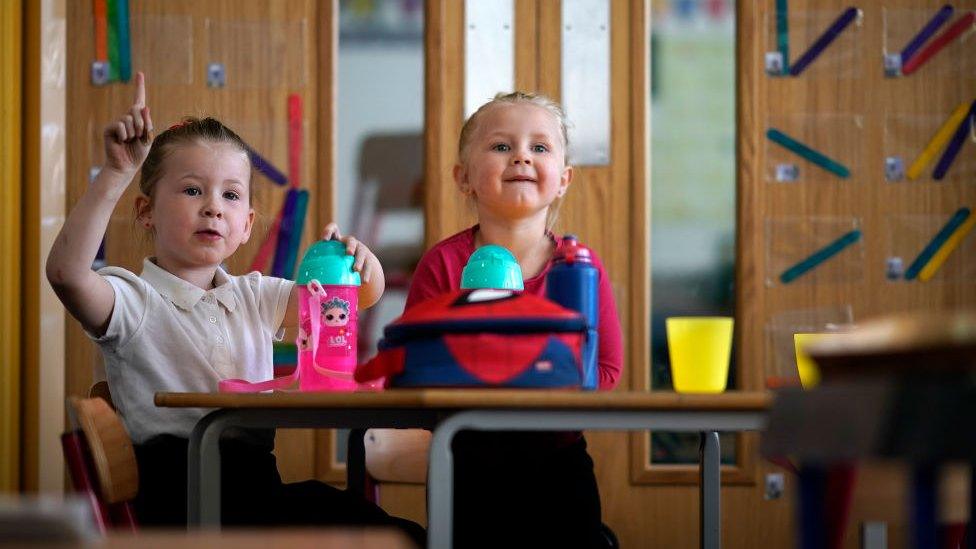The government's tricky move to get kids back to school
- Published

"I'm so angry and disappointed. Our kids are going to suffer for years."
These are the words of one parent on hearing the news that the government had given up on its plan to get all children back to primary school in England before the end of the school term.
Some may be relieved that they don't have to make the decision themselves.
Others are perhaps resigned to the fact that they are in the strange and sometimes stressful world of homeschooling for the long haul - the online exercise hero Joe Wicks now more familiar than a relative, BBC Bitesize as much a part of the routine as jam on the four-year-old's toast.
But for families around the country, classrooms staying empty is not just about missing out on sports day or the summer fair.
It's not just about the huge stress for many parents trying to work, or find work, while juggling kids at home, rather than them being safely at school for most of the day.
And it's not even just about the loss of classroom learning or time with friends.
But for too many children it is about the loss of a place of safety, a gateway to opportunity and the wider world that not all families can provide in the same ways.
All those reasons explain why the government's decision to close schools near the start of the pandemic was taken so reluctantly, especially as the health risks to children from the virus are low and their role in transmitting the infection is unclear.
But when the choice was made, it was easy for ministers to make it happen.
Today, the move to get millions back to school is proving to be the opposite.
Remember most schools have stayed open in some fashion, providing education to key workers' kids and providing provision for the most vulnerable.
But in the week when Boris Johnson announced that all Reception, Year 1 and Year 6 children should go back, only 52% of schools opened their doors to the others, and only 11% of children were in class.
Ministers always warned it would be a gradual return, but it's been so gradual that as the education secretary confirmed today, the idea of whole schools going back this term has been ditched and the picture for secondary schools is not completely clear.
There are obvious practical reasons why it has proved so tricky.
The health guidance says children shouldn't be in groups of more than 15 while they are at school.
Within those groups they don't always have to stay at a two-metre gap from each other.
But the "keep your distance" rules are the principle.
That means schools need space they just don't have.
Creating more classes to keep the risks from the virus down does not create more computer rooms, libraries or assembly halls, more classrooms, or more teachers to teach.
Schools and unions had several weeks' notice to get ready for the start of the big return, but the practical considerations and fears about the progress of the disease worked against it happening.
And the nature of the school system made it harder too. It's a patchwork, even in England.
The Department for Education can set a policy. But there are academy schools that are sometimes run by big chains, schools that operate under the auspices of local councils, and private schools and head teachers and school governors bodies have their own powers.
Gavin Williamson says he is "working to bring all children back to school in September" across England
And then, like it or not, education is intensely political too, with the sometimes competing influences of national government, local government and the teaching unions.
Of course, they would all say they have the best interest of kids at the forefront of their minds, but they are different beasts, with different overall political priorities and that matters.
So although central government can make big political promises to parents and pupils, and really wish things happen, in the end they don't hold the chalk at the blackboard or the keys to the school gate.
And Whitehall also doesn't control what will happen to pupils in the rest of the UK - you can read about the different timetables for returns to the classroom here.
However the practicalities can be explained away, and it is true that the government always said the return was an ambition not a firm plan, the retreat from the full return looks messy and gives the impression to millions of families that Downing Street didn't deliver what they promised.
There is a reluctant sense in government that they were damned if they set out a timetable that they then failed to keep to, and damned if they continued to leave the nation's diaries blank for months.
Remember for several weeks opposition politicians were calling for Number 10 to give their exit strategy as quickly as they could.
When it was published, the documents and the speeches were full of "ifs" and "buts".
But there is a curious sense of impotence about all of this.
Getting kids back to school in big numbers was always going to be tricky, it was always going to be gradual.
But even some Tory MPs worry that there is a sense of drift exemplified by how this halting return has unfolded.
Politics is about expectation and making things happen, not just being able to provide excuses when things go awry.
- Published23 February 2022

